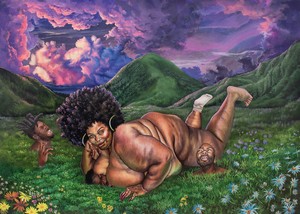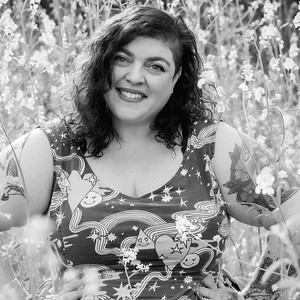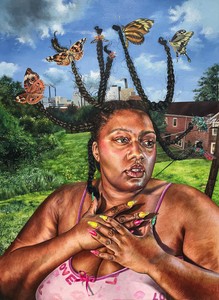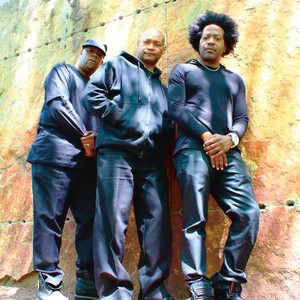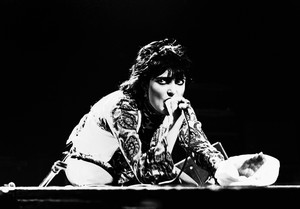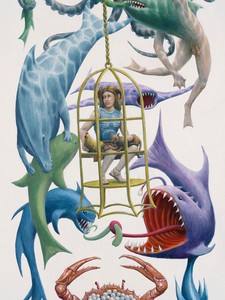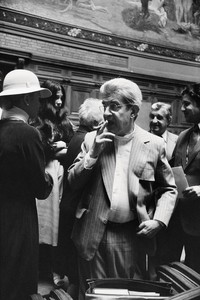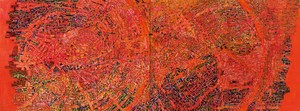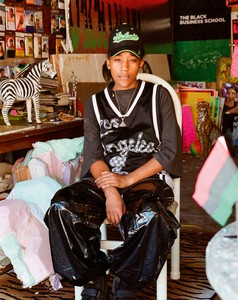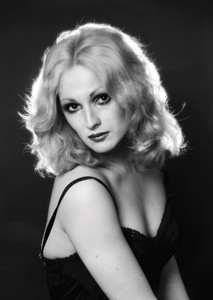Kezia Harrell’s Such Gatherings (2020) is a landscape of purple sky, rolling green hills, and green grass, a fat Black woman at its center. She lies on her voluminous belly, her ample bottom, back rolls, and legs behind her in the air, one foot wearing a sock, one bare. Her breasts squash a man’s face beneath her. Two more men’s faces bloom from the grass around her, bearing looks of anguish. Her own face shows a calm ecstasy. Her hair is a natural afro haloed around her and her hoop earrings bracket her smile. She rests her chin in her hand, her fingers tipped with long curling red nails. She is a goddess, outside of time and place. Her cheekbones shine.
“My work is very personal; it’s annoying,” Harrell says, laughing. “My art is figurative and abstract. I’m always thinking about my process. My work doesn’t have an already-set-in-stone place to exist, so I created it. There’s no such thing as a place African Americans are indigenous to, so I’m just taking concepts of Americana and placing them as a forever land, a land for us to exist in in all our joy and glory. And all of our chaos.”
The anguished faces in Such Gatherings, a work in marker and gouache on cotton paper, are part of that chaos. “The land I paint exists inside those questions. How do you get to such a place? It’s so scary,” the artist says.
Harrell attended the San Francisco Art Institute, where she studied with the painter Brett Reichman—“the modern-day Caravaggio,” she calls him. She was a natural artist as a child and studied anatomy in high school. “I took my art very seriously early on,” she says. “My concepts now rise from everything, the whole life of the person. I have to document real Black people. I’m deeply connected with my child roots. I research and study everything.”
Harrell’s work has a powerful sense of embodiment, which her materials accent and access. “I use everything. I am very technical and do research on the materials. My drawings are ink, alcohol marker, colored pencil, everything, but I ensure that everything is layered correctly and is in harmony.” A self-described survivor and old-school oil painter, she finds validation in telling her own story. Bliss: Americana Hot Mamma (2021) is a self-portrait in oil on a birch panel. A forever-land cherub covered in purple fur blows bubbles at a nude figure reclining peacefully, her braids floating up in bows, her nipples and abdomen dusted with golden glitter. Fat women are so rarely shown this accurately and lovingly; the figure’s knees dimple, her side rolls rest against grass, and her large belly hangs peacefully on her rippled thighs. “I love painting my body,” Harrell says, “because I can make it do all sorts of weird stuff. I visualize my body as a thing I can admire . . . a system [I] belong to.”
Bodies and time work in abundant ways in Harrell’s art. In pieces such as Butterflies Are Bows (2019), Black women pose with their braids floating high above them, carried up by butterflies. In Butterflies Are Bows #2 (Home Is Where The Heart Is) (2020) the figure’s long nails are pastel pink, yellow, and green, signaling a rich and fertile alternative Easter season. The work is made in chalk pastel in addition to her usual ink and gouache, bringing fertile elements to the figures and setting. Two of the braids are carried up by orchid bees, gemlike, brilliant-colored insects that don’t make honey but exist solely to pollinate exotic flowers and capture their perfume for mating. The piece shows the powerful, dormant, and cyclical power of the natural world in her work’s forever land.
What’s next for Harrell? “I’ve been working on a graphic novel. It’s connected to all the work. I am a part of all of my artist ancestors. I tap into Black Dada, the Black renaissance in Harlem, Afrofuturism. And I love Octavia Butler,” she says. Harrell is drawn presently to New Age painters “documenting the experiences of people who didn’t get to be documented in time, who were captured out of time, their narratives, their personal stories: millions that weren’t stored into time. It’s about that. It’s actually about archiving Black life. That’s what my work gets to do; it gets to archive my Black life. One of many millions. It’s very spiritual.”

